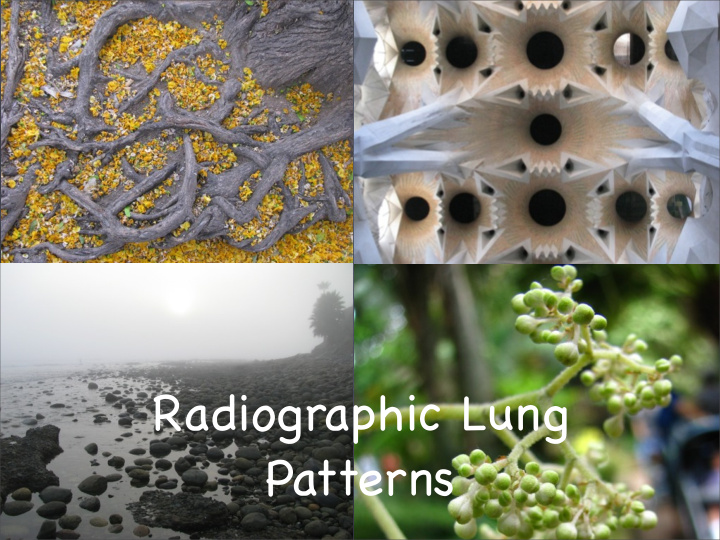



Radiographic Lung Patterns
Systematic approach heart mediastinum vessels lungs pleural space thoracic wall diaphragm/abdomen
Lung pathology Most cause Some cause INCREASED OPACITY DECREASED OPACITY patterns emphysema, air trapping INTERSTITIAL hypoperfusion ALVEOLAR PTE BRONCHIAL VASCULAR NODULAR
Approach Is there increased opacity? What is the pattern(s)? What is the distribution?
DISTRIBUTION PATTERN FOCAL/MULTIFOCAL NODULAR ALVEOLAR INTERSTITIAL DIFFUSE INTERSTITIAL BRONCHIAL VASCULAR
VASCULAR
Vascular pattern What you will see... DIFFUSE increased opacity Due to: Multiple enlarged pulmonary vessels Veins Arteries BOTH
Vascular pattern Remember compare: 4th rib cranial vessels to: 9th rib caudal vessels to: Artery and vein should be: same size or smaller than rib similar size to each other
Vascular BIG ARTERIES BIG VEINS BIG VEINS normal VEINS normal ARTERIES BIG ARTERIES Pulmonary Left heart Overcirculation hypertension failure
BRONCHIAL
Bronchial pattern What you will see... DIFFUSE increased opacity Due to... Prominent bronchial walls “RAILROAD TRACKS” “DONUTS” out to PERIPHERY
Bronchial pattern DIFFERENTIALS Chronic bronchitis allergic, irritant Feline asthma Infectious bronchitis Lungworms Heartworm disease
INTERSTITIAL
Interstitial pattern What you will see... DIFFUSE or FOCAL UNSTRUCTURED haziness BLURRING of vessel margins Due to: interstitial fluid or cells ARTIFACT
Interstitial pattern
Interstitial Differentials Artifact - expiratory, obesity “old-dog” lungs Pneumonitis viral, parasitic, metabolic, toxic Alveolar disease in transition Pulmonary fibrosis ARDS Neoplasia - RARE (LSA, mets)
Bronchial vs. Interstitial
Bronchial vs. Interstitial
DIFFUSE increased opacity Is opacity made up of STRUCTURES or MARKINGS? NO YES hazy blurred vessels donuts vessels RR tracks VASCULAR BRONCHIAL INTERSTITIAL
ALVEOLAR
Alveolar pattern What you will see... FOCAL or MULTIFOCAL distribution Uniform fluid opacity - fluffy to solid Due to: cells/fluid filling alveoli
Alveolar pattern continuum with INTERSTITIAL AIR BRONCHOGRAMS LOBAR SIGN SILHOUETTE SIGN
Air Bronchogram Branching BLACK airway WHITE background CAN’T see vessels no yes yes no
Lobar sign Periphery of lobe affected Abrupt demarcation between diseased and normal lung DON’T confuse with PLEURAL FISSURES
Silhouette sign Adjacent to ST structure Effacement of margins cardiac silhouette pulmonary vessels diaphragm
Alveolar pattern BIG 3 Differentials: hemorrhage, contusions BLOOD PUS pneumonia edema WATER Other Differentials: Atelectasis Neoplasia Lung lobe torsion
Alveolar Location? CRANIOVENTRAL HILAR CAUDODORSAL Cardiogenic Non-cardiogenic Pneumonia pulmonary pulmonary edema edema Hemorrhage Hemorrhage Hemorrhage
NODULAR
Nodular Pattern AKA = structured interstitial What you will see... FOCAL or MULTIFOCAL opacities Due to: nodules or masses MUST define characteristics of nodule(s)!!
Differentials for nodules H ematoma - trauma A bscess - foreign body N eoplasia - primary and metastatic G ranuloma - fungal, parasitic B ulla - air or fluid filled
Nodule characteristics NUMBER - Single vs. Multiple SIZE - overall and relative nodule vs. mass (>3 cm) similar vs. variable MARGINATION well defined vs. ill defined
Single Nodule/Mass WELL-DEFINED margins ILL-DEFINED margins NEOPLASIA!! ABSCESS GRANULOMA Primary vs. single metastatic nodule > 3 cm more likely PRIMARY tumor BULLA, HEMATOMA
Multiple Nodules/Masses Fungal Pneumonia Metastatic Neoplasia MARGINS ILL-DEFINED WELL-DEFINED SIMILARLY SIZE VARIABLY small, miliary OTHER LYMPHADENOPATHY SYMPTOMATIC
Margination If you see both ILL and WELL DEFINED? ILL DEFINED won’ t look WELL DEFINED BUT.. WELL DEFINED can look ILL DEFINED Due to: respiratory motion silhouetting associated hemorrhage or inflammation
Cavitated Nodules Soft tissue and AIR WALL THICKNESS!! Differentials H A N G with necrosis thick irregular wall Bulla thin wall
Nodular pattern BEWARE OF IMPOSTORS... REMEMBER REAL NODULES! size > 5mm End on vessels on BOTH views Surface structures ST opacity Pulmonary osteomas
SUMMARY
PATTERN SIGNS f NODULAR focal/multifocal nodules o c air bronchogram a ALVEOLAR silhouette sign l lobar sign d INTERSTITIAL blurring of vessels i f f BRONCHIAL railroad tracks, donuts u s VASCULAR enlarged pulm vessels e
Recommend
More recommend